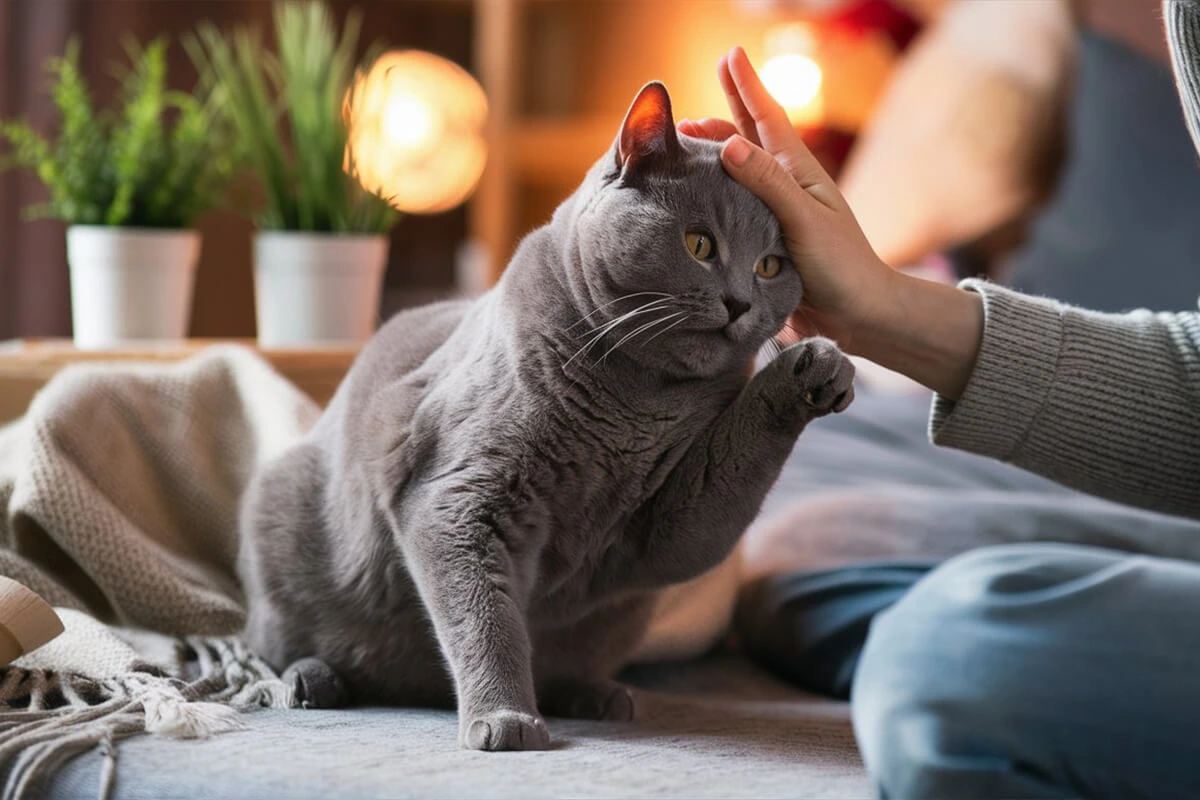Grey cat personality is a fascinating blend of charm, intelligence, and affection, making these felines irresistible to many cat lovers. Whether you have a sleek Russian Blue, a plush British Shorthair, or a playful Domestic Shorthair, grey cats often exhibit unique traits that set them apart. Their personalities range from affectionate lap cats to independent yet loyal companions, offering something for every pet owner.
Understanding the temperament of grey cats helps potential owners know what to expect when bringing one home. Some grey cats, like the Chartreux, tend to be quiet and observant, while others, such as the Russian Blue, are known for their intelligence and deep bonds with their owners. No matter the breed, grey cats captivate people with their mysterious aura and endearing behavior.
In this post, we’ll explore the personality of grey cats in detail, breaking down their behavior, temperament, and compatibility with different lifestyles. Whether you’re considering adopting one or already have a grey feline friend, this guide will help you appreciate their charming traits even more.
The Unique Personality of Grey Cats
General Temperament of Grey Cats
Grey cats often exhibit a well-balanced temperament that combines intelligence, affection, and independence. Grey cat personality varies across breeds, but many, such as the Russian Blue and British Shorthair, display calm and composed traits, making them excellent companions for various households. These cats tend to be observant and cautious but also form deep bonds with their owners.
Some grey cats lean toward being playful and interactive, while others prefer a more relaxed and independent lifestyle. For example, Chartreux cats love engaging in games but remain gentle and quiet, making them ideal for people who prefer a low-energy but affectionate pet. Domestic Shorthair grey cats, on the other hand, have personalities that vary greatly depending on their genetics and upbringing. Understanding grey cat personality helps owners provide the right environment and care for their feline companions.
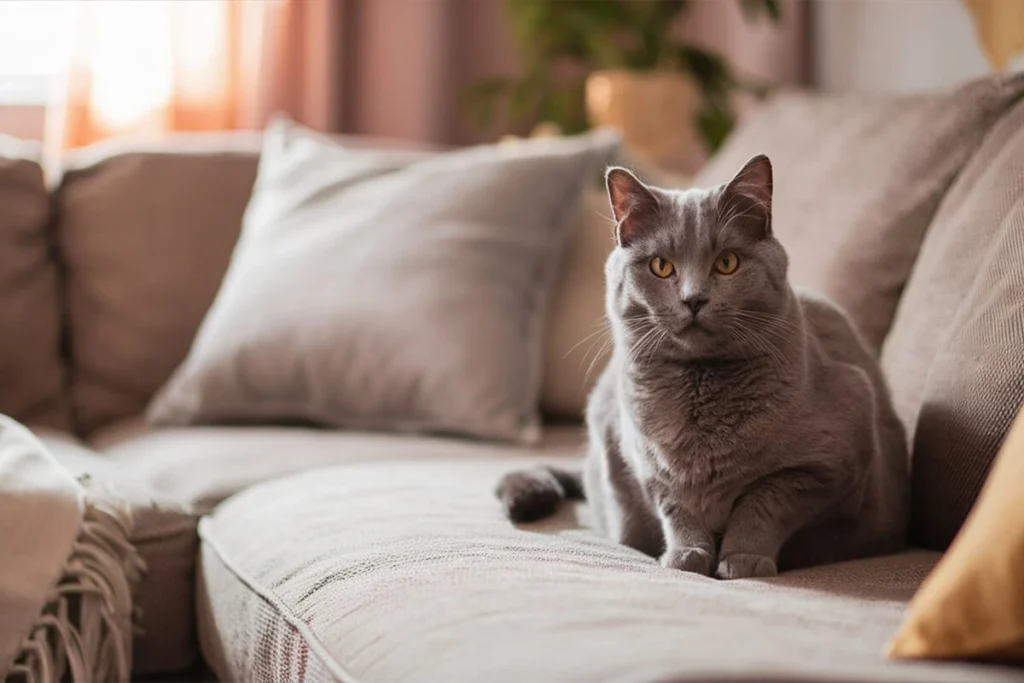
While each grey cat has a unique personality, most share a few key traits: a sense of curiosity, a preference for routine, and an ability to adapt well to their environment. These cats often enjoy peaceful surroundings but can also thrive in active households with the right socialization. Whether playful or reserved, grey cat personality consistently offers a charming mix of intelligence and affection that cat lovers adore.
Are Grey Cats Friendly?
Many grey cats are friendly, but their level of sociability depends on their breed and individual personality. Russian Blues tend to be reserved around strangers but show immense loyalty and affection toward their owners. British Shorthairs enjoy human companionship but prefer attention on their terms, making them excellent pets for busy individuals who want a low-maintenance yet loving cat.
Some grey cats, like Domestic Shorthairs, vary in friendliness based on their early socialization experiences. If a kitten receives plenty of positive human interaction from a young age, they are more likely to develop into a friendly and outgoing adult cat. Chartreux cats, in contrast, are naturally affectionate and often follow their owners around, seeking companionship without being overly demanding.
Grey cats might take some time to warm up to new people, but once they trust someone, they form deep and lasting bonds. Their affectionate nature makes them great pets for singles, families, and seniors alike.
Common Behavioral Traits in Grey Felines
Grey cat personality includes several common behavioral traits that make these felines stand out. Many grey cats have a strong sense of independence and enjoy spending time alone but still appreciate affection from their owners. Russian Blues, for example, often observe their surroundings from a distance before deciding to engage, while British Shorthairs prefer relaxed and laid-back interactions. This balance of independence and affection makes grey cat personality highly adaptable to different households.
Intelligence plays a major role in grey cat behavior. These felines quickly learn routines, recognize their owners’ habits, and even respond to commands when properly trained. Puzzle toys and interactive games help keep their minds sharp, preventing boredom and destructive behavior. Their ability to problem-solve and adapt adds to the charm of grey cat personality, making them intriguing and engaging pets.
Most grey cats also value routine and predictability. They thrive when their feeding schedule, playtime, and resting spots remain consistent. Sudden changes in their environment or schedule might make them anxious, so gradual adjustments work best when introducing new experiences.
In addition to their intelligence and independence, grey cats tend to have a playful yet gentle demeanor. They enjoy interactive play, whether it’s chasing a feather toy or pouncing on a moving object. However, they usually balance their energy levels well, meaning they won’t be overly hyperactive or demanding. Their ability to adapt to different households makes them excellent companions for various lifestyles, further proving why grey cat personality is so beloved by cat owners.
Popular Grey Cat Breeds and Their Personalities
Russian Blue Temperament
The Russian Blue has a temperament that combines intelligence, loyalty, and a touch of shyness. These cats observe their surroundings carefully before engaging, making them appear reserved at first. However, once they bond with their owners, they show deep affection and devotion. Russian Blues often follow their favorite humans around the house, seeking companionship without being overly demanding.
This breed values routine and consistency. Russian Blues dislike sudden changes in their environment and may take time to adjust to new people or situations. However, their adaptability improves when they receive gentle socialization from an early age. These cats prefer a quiet, stable home where they can feel secure.
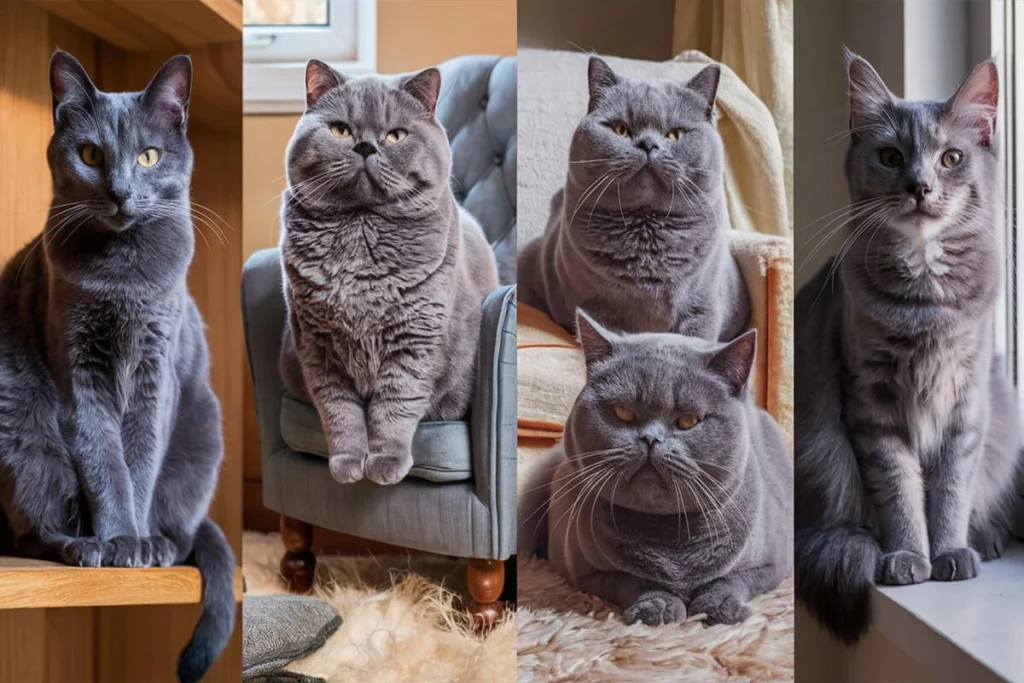
Their intelligence makes them quick learners. Russian Blues can figure out how to open doors, solve puzzle toys, and even learn basic commands. They enjoy interactive play but also appreciate their alone time. If left alone during the day, they entertain themselves as long as they have stimulating toys and cozy resting spots.
British Shorthair Cat Personality
The British Shorthair has a calm and easygoing personality that makes it a favorite among cat lovers. These cats enjoy human companionship but prefer interactions on their terms. They don’t demand constant attention but appreciate being near their owners, often lounging in the same room without being overly clingy.
Unlike some breeds that crave constant activity, British Shorthairs enjoy a more laid-back lifestyle. They love to nap, watch their surroundings, and engage in short bursts of play. Their playful side emerges when they chase a toy or bat at an object, but they don’t have the high-energy levels of some other breeds.
These cats get along well with families, singles, and seniors. They tolerate children and other pets, but they prefer gentle interactions. British Shorthairs rarely show aggression, and their calm demeanor makes them ideal for people looking for a relaxed and affectionate companion.
Chartreux Characteristics
The Chartreux stands out for its playful, intelligent, and affectionate nature. Unlike some reserved cat breeds, the Chartreux enjoys interactive play and forms strong bonds with its family members. These cats follow their owners from room to room and often initiate playtime.
Despite their playful personality, Chartreux cats remain gentle and quiet. They rarely vocalize, communicating more through body language than meowing. Their quiet nature makes them ideal for apartments or homes where noise levels need to stay low.
Chartreux cats are known for being very good hunters. They enjoy chasing small toys, pouncing on objects, and displaying their natural hunting instincts. Their agility and sharp reflexes make them entertaining to watch during playtime. However, they also enjoy snuggling up next to their owners when they wind down.
Domestic Shorthair Grey Cats
Domestic Shorthair grey cats have a wide range of personalities due to their diverse genetic backgrounds. Some are affectionate lap cats, while others prefer independence. Their temperament depends largely on their early socialization, environment, and individual traits.
One common trait among many Domestic Shorthairs is their adaptability. These cats adjust well to different households, making them great pets for families, singles, and seniors. They don’t belong to a specific breed, so their personality varies more than purebred cats like Russian Blues or British Shorthairs.
Some grey Domestic Shorthairs develop strong attachments to their owners, following them around and seeking attention. Others may be more independent, enjoying occasional affection but preferring to do their own thing. Since their personalities differ, understanding a Domestic Shorthair’s temperament requires spending time with them and observing their unique behaviors.
Regardless of their specific traits, most Domestic Shorthairs enjoy a mix of play and relaxation. They entertain themselves with toys, explore their surroundings with curiosity, and love sunbathing near a window. Their versatility and charm make them a popular choice for cat lovers of all kinds.
Grey Cat Behavior: What to Expect
Social vs. Independent Tendencies
Grey cat personality includes a unique mix of social and independent tendencies, depending on breed and individual traits. Some grey cats, like the Chartreux and Domestic Shorthair, enjoy frequent interaction with their owners and seek companionship throughout the day. They follow their favorite humans from room to room, showing their affectionate nature without being overly clingy. These cats thrive on attention and engage in playful activities whenever their owners are nearby, making them ideal for people who want an interactive pet.
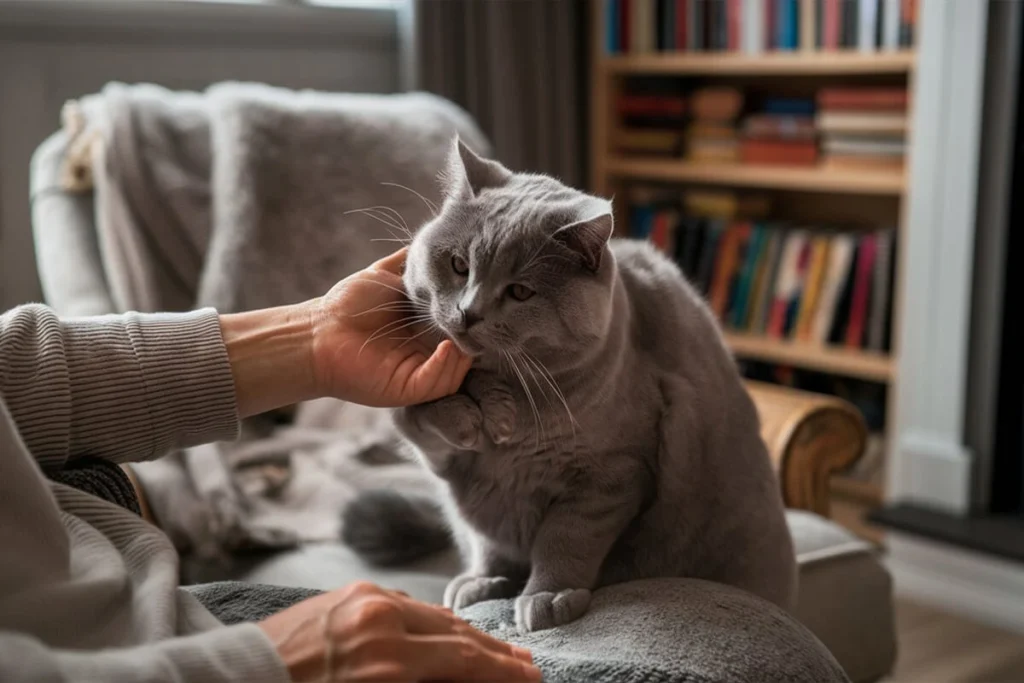
Other grey cats, such as the Russian Blue and British Shorthair, prefer a more independent approach to socialization. They enjoy their owner’s company but often observe from a distance before deciding to interact. Russian Blues, for example, form deep bonds but take their time warming up to new people. British Shorthairs enjoy companionship but don’t demand constant attention, making them great pets for busy individuals who want a relaxed but loving companion. These subtle differences in grey cat personality allow owners to find the perfect feline match for their lifestyle.
Regardless of breed, most grey cats balance social engagement and independence. They appreciate alone time but also enjoy moments of affection and play. Understanding their social needs helps owners create the right environment where their grey cat feels secure and comfortable. Whether playful and affectionate or reserved and observant, grey cat personality consistently offers a wonderful combination of charm, intelligence, and adaptability.
Interaction with Pet Owners and Other Animals
Grey cats interact with their owners in different ways based on their temperament. Some, like the Chartreux, actively seek out human interaction, rubbing against their owners, curling up next to them, and even following them around the house. These cats crave affection and enjoy forming close bonds with their families.
Russian Blues, on the other hand, build trust gradually. They observe their owners’ behaviors before engaging but become deeply loyal once they feel safe. These cats often form a strong attachment to one person and prefer predictable routines in their interactions.
When it comes to other animals, grey cats exhibit different responses based on their socialization and personality. Some breeds, like the British Shorthair, tolerate other pets well but prefer their own space. They coexist peacefully with dogs and other cats as long as their boundaries get respected. Domestic Shorthairs have varying reactions to other pets, depending on their individual temperament and experiences. If raised with other animals, they often develop friendly relationships and enjoy playing together.
Introducing a grey cat to another pet requires patience. Gradual introductions help them feel safe, and positive reinforcement encourages good behavior. Socialized grey cats often develop strong friendships with other household pets, but some prefer to remain the dominant or solitary companion.
How Their Personality Influences Their Daily Routine
A grey cat’s personality plays a significant role in shaping its daily routine. Cats with an active and playful temperament, like the Chartreux and some Domestic Shorthairs, spend more time engaging in play, climbing furniture, and exploring their surroundings. They need interactive toys, scratching posts, and regular play sessions to keep them stimulated.
More reserved breeds, such as the Russian Blue and British Shorthair, prefer structured routines. They expect meals, playtime, and relaxation to follow a consistent schedule. Disrupting their routine may cause stress, so owners should maintain regular feeding times and a predictable environment. These cats often choose a favorite spot in the house for napping and stick to familiar spaces where they feel secure.
Some grey cats enjoy bursts of high-energy activity followed by long periods of relaxation. They wake up early for a morning play session, nap through the afternoon, and seek attention from their owners in the evening. Understanding these patterns helps owners provide enrichment, ensuring their grey cat remains happy and engaged throughout the day.
Whether playful or laid-back, social or independent, grey cats develop daily routines that match their personalities. Owners who recognize and adapt to these tendencies create a harmonious environment where their feline companions can thrive.
Do Grey Cats Make Good Pets?
Compatibility with Families, Singles, and Seniors
Grey cats make excellent companions for a wide range of households, adapting well to different lifestyles based on their breed and personality. Some grey cats thrive in active family homes, while others prefer the quiet companionship of a single owner or senior.
Families with children benefit from adopting a patient and affectionate grey cat, such as the British Shorthair or Chartreux. These breeds tolerate gentle handling and enjoy social interaction, making them great family pets. British Shorthairs, in particular, love spending time with their owners without being overly demanding. Their calm nature allows them to fit seamlessly into busy households where they can observe the activity without feeling overwhelmed.
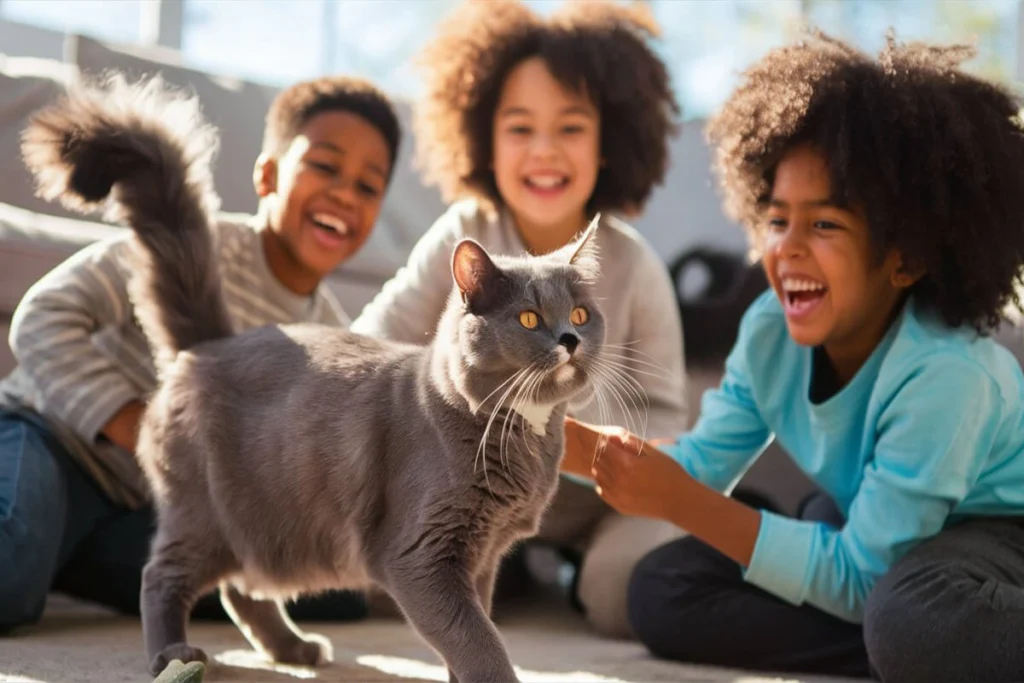
Singles who prefer a close bond with their cat may find the Russian Blue or a friendly Domestic Shorthair ideal. Russian Blues tend to form strong attachments to one person, following their owner around and showing quiet affection. A single person who wants a loyal and intelligent companion will enjoy the deep connection this breed offers. Domestic Shorthairs, depending on their temperament, also make wonderful pets for singles who want a mix of independence and companionship.
Seniors looking for a relaxed and loving companion will appreciate the British Shorthair or Chartreux. Both breeds offer gentle affection without excessive demands for attention. They enjoy quiet environments and settle into predictable routines, making them great choices for older individuals seeking a low-energy but devoted pet.
Are They Good with Kids and Other Pets?
Grey cats vary in their tolerance of children and other animals, but many breeds adapt well to multi-pet households and families with kids. British Shorthairs and Chartreux cats, for example, display patience and gentle behavior, making them great companions for respectful children. These cats tolerate petting and playful interactions but prefer calm handling over rough play. Teaching kids how to interact with cats properly ensures a positive relationship.
Russian Blues, while affectionate with their owners, often take longer to warm up to young children. They prefer peaceful environments and may retreat to a quiet space if a household becomes too chaotic. However, with patience and socialization, they can coexist with older children who understand their need for space.
When it comes to other pets, grey cats have different levels of adaptability. British Shorthairs generally tolerate dogs and other cats, as long as introductions happen gradually. Chartreux cats also adjust well to other pets, often forming close bonds with friendly animals in the home.
Domestic Shorthairs vary in their interactions with other animals. Some develop strong friendships with other cats and dogs, while others prefer to remain the only pet in the household. Early exposure to other animals increases the likelihood of a grey cat forming positive relationships with new companions.
Low-Maintenance vs. High-Maintenance Breeds
Grey cats require different levels of care based on their breed and coat type. Some grey breeds demand regular grooming and structured routines, while others adapt easily to low-maintenance lifestyles.
British Shorthairs and Russian Blues fall into the low-maintenance category. Their short, dense coats require minimal grooming, with a weekly brushing session keeping their fur in excellent condition. They also maintain a balanced energy level, enjoying playtime but not requiring constant stimulation. These cats suit owners who want a relaxed pet without extensive care requirements.
Chartreux cats also have a short coat but benefit from regular brushing to prevent shedding. While not as high-maintenance as long-haired breeds, they need occasional grooming to keep their fur soft and healthy. They enjoy interactive play but don’t demand constant attention, making them moderately low-maintenance pets.
Domestic Shorthairs vary in maintenance needs depending on their coat length and activity levels. Short-haired grey cats require little grooming, while those with slightly longer fur need more frequent brushing. Their energy levels range from laid-back to highly active, meaning some Domestic Shorthairs require more mental and physical stimulation than others.
Owners who prefer a low-maintenance pet should choose a breed with a short coat and a calm personality. Those who enjoy engaging with an active, playful cat may find a more energetic grey breed suits them best. Understanding the maintenance requirements of each breed helps owners provide the best care for their feline companions.
Tips for Caring for a Grey Cat Based on Their Temperament
Creating a Comfortable Environment for Your Grey Cat
Grey cats feel most secure in an environment that caters to their natural instincts and personality traits. Whether they enjoy lounging in quiet spaces or exploring their surroundings, providing a safe and stimulating home helps them thrive.
Start by setting up cozy resting areas throughout your home. Many grey cats, including British Shorthairs and Russian Blues, love having a designated spot where they can retreat when they need alone time. A soft bed in a quiet corner, a sunny windowsill, or a plush cat tree with elevated perches offers them a sense of security.
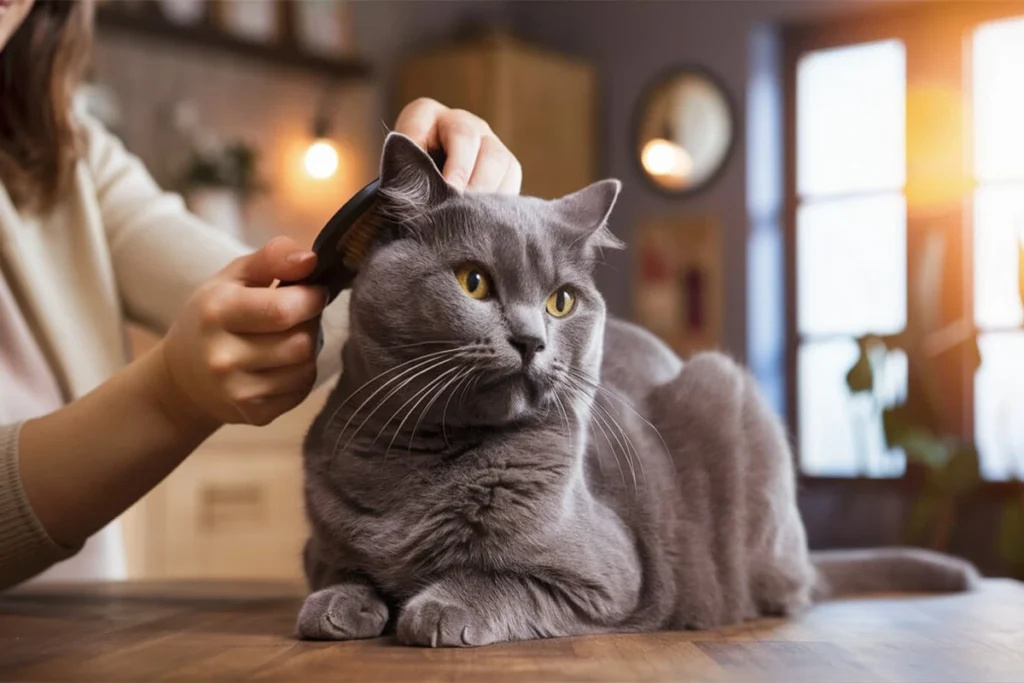
Give your grey cat access to vertical spaces. Cats enjoy climbing and observing their surroundings from above, so installing cat shelves, towers, or window perches keeps them entertained. Chartreux cats, known for their playful yet quiet nature, appreciate a variety of spaces where they can hide and relax.
Maintain a consistent routine to help your grey cat feel comfortable. These felines thrive on predictability, so keeping regular feeding times, play sessions, and quiet periods reduces stress. Russian Blues, in particular, prefer stability and may become anxious if their routine changes suddenly.
Provide a variety of enrichment toys to keep your grey cat mentally stimulated. Puzzle feeders, interactive toys, and scratching posts satisfy their natural curiosity and help prevent boredom. Cats that receive enough mental stimulation stay happier and healthier in the long run.
Understanding Their Activity Levels and Play Needs
Grey cats have different activity levels depending on their breed and personality. Some grey cats, such as Chartreux and Domestic Shorthairs, enjoy frequent bursts of play, while others, like Russian Blues and British Shorthairs, prefer calmer activities with occasional exercise.
Active grey cats need plenty of opportunities to burn off energy. Chartreux cats, for example, love chasing toys, climbing furniture, and engaging in interactive play. Owners should provide feather wands, balls, and other moving toys to satisfy their playful instincts. Play sessions should last at least 10 to 15 minutes a few times a day to keep them physically and mentally engaged.
More reserved breeds, like the Russian Blue, prefer structured playtime rather than spontaneous bursts of energy. They enjoy puzzle toys, gentle interactive games, and controlled play rather than high-energy activities. These cats often enjoy playing in short sessions before retreating to a quiet spot to relax.
British Shorthairs have a lower activity level than some other grey cat breeds. They enjoy moderate playtime but prefer lounging and watching their surroundings. Providing soft toys or slow-moving interactive games suits their relaxed nature.
Domestic Shorthair grey cats display a range of activity levels, depending on their genetics and upbringing. Some enjoy constant movement and interactive play, while others lean toward a more relaxed routine. Observing their individual preferences helps owners tailor playtime to their cat’s energy level.
Regardless of their activity level, all grey cats benefit from regular physical and mental stimulation. Rotating toys, introducing new play styles, and engaging in short but frequent play sessions keep them happy and prevent boredom.
Grooming and Health Considerations for Different Grey Cat Breeds
Grooming needs vary among grey cat breeds, with some requiring minimal upkeep while others need regular brushing to maintain their coat’s health. Understanding a breed’s grooming requirements helps owners keep their grey cat looking and feeling their best.
Russian Blues and British Shorthairs have short, dense coats that require little grooming. A weekly brushing session removes loose hair and reduces shedding. These breeds also produce less dander than other cats, making them a good choice for allergy sufferers. Regular brushing keeps their fur sleek and minimizes hairballs.
Chartreux cats have a thick, woolly coat that benefits from frequent brushing. Owners should brush them two to three times a week to prevent matting and reduce shedding. Their fur repels dirt naturally, but regular grooming keeps their coat in excellent condition.
Domestic Shorthair grey cats have varying coat textures, so their grooming needs depend on their individual fur type. Short-haired Domestic Shorthairs require weekly brushing, while those with slightly longer fur may need grooming two or three times a week to prevent tangles.
In addition to grooming, owners should monitor their grey cat’s health by scheduling regular vet checkups. Russian Blues and British Shorthairs are prone to weight gain, so maintaining a balanced diet and encouraging exercise prevents obesity-related health issues. Chartreux cats sometimes develop joint problems, making it important to provide soft bedding and a diet rich in nutrients that support joint health.
Routine dental care also plays a role in a grey cat’s overall well-being. Brushing their teeth regularly and providing dental treats or chew toys helps prevent gum disease and plaque buildup.
By understanding their grey cat’s grooming and health needs, owners ensure their feline companions stay happy, comfortable, and well cared for throughout their lives.
Conclusion
Grey cats captivate cat lovers with their unique personalities, charming traits, and striking appearance. Their temperament varies depending on breed and upbringing, but they all share a special blend of intelligence, affection, and independence. Whether you choose a Russian Blue, British Shorthair, Chartreux, or a Domestic Shorthair, understanding grey cat personality helps you build a strong bond with your feline companion.
Some grey cats, like the Chartreux and Domestic Shorthair, enjoy playful interactions and social engagement, while others, such as the Russian Blue and British Shorthair, prefer a quiet and predictable environment. Knowing their social tendencies allows pet owners to create a home that suits their cat’s needs, ensuring a happy and well-adjusted pet.
Grey cats also vary in their compatibility with families, singles, and seniors. Some breeds thrive in active households with children and other pets, while others prefer a calmer atmosphere with one or two dedicated caregivers. Recognizing these differences helps potential pet owners select the right grey cat for their lifestyle.
Caring for a grey cat requires attention to their activity levels, grooming needs, and overall well-being. Some breeds, like the Russian Blue and British Shorthair, require minimal maintenance, while others, such as the Chartreux, benefit from more frequent brushing. Regular vet checkups, balanced nutrition, and engaging playtime contribute to a grey cat’s long-term health and happiness.
No matter the breed, grey cats bring warmth, companionship, and charm into their owners’ lives. Their gentle yet independent nature makes them beloved pets for many households. By understanding grey cat personality and meeting their unique needs, owners can create a loving environment where their feline friend thrives for years to come.
Read More About the Grey Cat Breed On this Page
Learn More about Pets and Breeds From Here
You Can Find Some Good stuff for your Furry Cat on Pet MD Official
